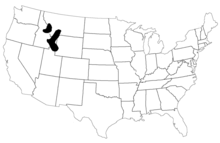Idaho pocket gopher
| Idaho pocket gopher | |
|---|---|
| Scientific classification | |
| Domain: | Eukaryota |
| Kingdom: | Animalia |
| Phylum: | Chordata |
| Class: | Mammalia |
| Order: | Rodentia |
| Family: | Geomyidae |
| Genus: | Thomomys |
| Species: | T. idahoensis
|
| Binomial name | |
| Thomomys idahoensis Merriam, 1901
| |

| |
| Range of the Idaho pocket gopher in the United States | |
The Idaho pocket gopher (Thomomys idahoensis) is a species of
Taxonomy
Thomomys idahoensis was first described by
Subspecies
Three subspecies are recognized:
- T. i. idahoensis (Merriam, 1901) — high variance in size and coloration in different populations within the subspecies, found in eastern Idaho and nearby parts of Montana. The largest are found in the Snake River Plain.[4][3]
- T. i. pygmaeus (Merriam, 1901) — small and dark brown, found in southwestern Wyoming, southwestern Idaho, and northern Utah.[4][3] It is the only subspecies found in Utah.[6]
- T. i. confinus (Davis, 1937) — found in western Montana.[3][7]
Description
The size, weight, and hindfoot length of the Idaho pocket gopher are variable, although typically no more than 150 millimetres (5.9 in), 90 grams (3.2 oz), and 26 millimetres (1.0 in) for each, respectively. The color of the back ranges from yellowish brown with dark brown tipped hair to grayish brown or fully dark brown, fairly uniform overall. Most are dark gray around the nose. The ventral area is light gray and usually mixed with yellow and yellow-brown. The feet are whitish in appearance, with tail color varying between specimens.[4] It is paler in winter than summer.[8]
The gopher's skull is small and lightly built, with incisors that are slender and not
Distribution and habitat
The Idaho pocket gopher is found in the western
Behavior and ecology
Individuals live in burrows, with each gopher creating and living in its own burrow. They remain active for the entire year, and store excavated soil in their burrows, which stays after the snow has melted.
It is not known what the Idaho pocket gopher eats, although related species consume parts of plants from vegetation below and above ground level, mainly
Reproduction and life cycle
Little is known about the life history of this species, with no known data on breeding season and litter size. It most likely breeds in spring after the snow has melted.[3] It is likely similar to the northern pocket gopher with regards to breeding behavior: the latter species gestates for 19 to 20 days and bears between four and seven offspring.[1] Its lifespan is also unknown, although pocket gophers usually live for less than two years.[3]
Conservation
There is no known existence of this species in protective areas or captivity. It is protected by the US state of Montana. The
Sources
- ^ . Retrieved 12 November 2021.
- ^ Merriam, Clinton H. (1901). "Descriptions of twenty-three new pocket gophers of the genus Thomomys". Proceedings of the Biological Society of Washington. 14. Biological Society of Washington: 114. Retrieved 2 November 2022.
- ^ a b c d e f g h i j Wilson, Don E.; Ruff, Sue (eds.). The Smithsonian Book of North American Mammals. Smithsonian Institution. pp. 470–471.
- ^ JSTOR 1379034. Retrieved 1 November 2022.
- ^ Bailey, Vernon (1915). Revision of the Pocket Gophers of the Genus Thomomys. U.S. Government Printing Office.
- ^ a b Oliver, George V.; Pope, Theresa L.; Hersey, Kimberly Asmus. "Pocket gophers of conservational concern in Utah" (PDF). Utah Division of Wildlife Resources. Retrieved 2 November 2022.
- ITIS. Retrieved 2 November 2022.
- ^ a b Anthony, H. E. (1928). Field book of North American mammals; descriptions of every mammal known north of the Rio Grande, together with brief accounts of habits, geographical ranges, etc. G. P. Putnam's Sons. pp. 281–282. Retrieved 2 November 2022.

